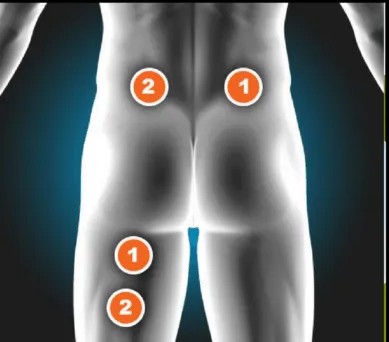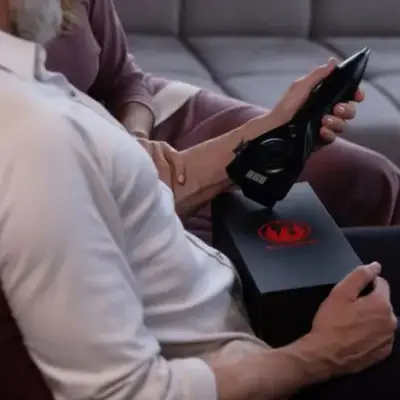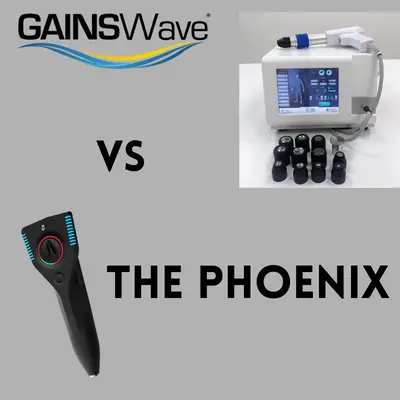Piriformis syndrome can be a pain in the butt, and, if you’ve experienced it, you’ll already know that. But when it strikes, do you really need to mess around with hot and cold packs or pop anti-inflammatory drugs? While searching for an answer, you’ve come across TENS, and you’re wondering if this could be a better alternative.
So, is a TENS unit good for piriformis? Yes. It’s been scientifically proven that TENS can relieve muscle pain, which is what piriformis syndrome causes. But, it doesn’t work for everyone or for all types of pain. Still, it has little risk of side-effects and is relatively cheap, so it’s low risk for potentially high rewards.
You might be thinking that a treatment that has no side-effects and is relatively cheap just sounds too good to be true. To address those concerns, we’ve included a more detailed look at how a TENS unit works and why it may be worth trying if you have piriformis syndrome. So, let’s start at the beginning.
TENS Placement for Piriformis Muscle

As you can see from the above picture you will want to place 2 TENS electrode pads on the side of your lower back where the pain is. Space the pads about an inch apart. You will want to place the 2 other pads on the back of your leg vertically as pictured.
When first using a TENS unit its always best to start of with the lowest level setting and increase it slowly until you feel a pulsating sensation. If at any point you feel pain or discomfort lower the setting! Using a TENS unit should be pain free and using a high setting will not result in better pain relief.
Best TENS Unit for Piriformis
This is the exact TENS unit that I use. It is perfect for alleviating many common types of pain. The iReliev is a great little device and has a lot going for it. It is well under $80 and has several programs to choose from and is small enough to fit in your pocket.
You do not need to spend hundreds of dollars to get a quality TENS unit and iReliev gives you a ton of value for the price being paid. Best part is they are based in Dallas, Texas and have phenomenal customer service FREE shipping and delivery in less than 5 days.
Get yours today on the iReliev website by clicking here.
What is a TENS Unit?
Well, a TENS unit is a small device that produces a mild electrical current that provides the stimulation to your skin.
It’s usually battery-operated, so portable, and it’s connected to conductive gel pads by wires. You apply the gel pads to your body, and the electrical impulse is conveyed to your skin through the gel pads. It’ll be a tingling sensation on the skin covered by the gel pads.
A TENS unit for home use doesn’t need a prescription, so it’s a treatment that’s easy to access.
How Does TENS Relieve Pain?
Gate Control Theory
TENS works on the basis of the gate control theory of pain. Some subsequent studies found an oversimplification in some of the details of the theory. Still, there remains a consensus that it’s a suitably unscientific way to explain the concept of pain to a non-scientific audience. So, keep reading.
The way it works is that sensory nerves send pain messages to your brain via your spinal cord. The role of your brain is to read those messages, and it then tells your body how to respond.
Underlying the gate control theory is the idea that pain messages can be prevented from reaching your brain. So, if no pain messages get through to it, your brain tells you everything is normal. It’s based on the concept of a gate mechanism within your spinal cord in the area just before it reaches your brain.
For them to reach your brain, the pain messages need the gate to be open. This can happen when there are more pain messages than non-pain messages. Think of it as the pain messages wedging the gate open through force of numbers. So, the pain messages pass freely through the gate and on to your brain.
However, the gate can be closed if there’s a higher number of non-pain messages reaching this area. It’s as if the non-pain messages overwhelm the pain messages, pass through the gate, and then close it behind them. So, the non-pain messages continue on their merry way to your brain. In the meantime, the pain messages are stuck on the wrong side of the closed gate.
Want to know where else a TENS unit can be placed? Check out my TENS placement guide here
Knee Pain
Neck Pain
Shoulder Pain
Tension Headaches
Golfer’s Elbow
Plantar Fasciitis
Rotator Cuff Pain
Restless Leg Syndrome
Ulnar Nerve Pain
TMJ Pain
The Role of TENS
So, TENS is used to stimulate your sensory nerves to produce enough non-pain messages, to outnumber the pain messages.
What it boils down to is the manipulation of the signals that your brain receives from your sensory nerves to stop pain messages reaching your brain.
Now, there’s no consensus on the effectiveness of TENS to treat all pain types, so you shouldn’t be under the impression that it’s going to work for everyone. However, some studies have shown that it does work for some patients, with minimal risk of side-effects. Therefore, the view is that it’s at least a useful addition to the methods that can be used to treat pain.
Will a TENS Unit Work for Piriformis?
Well, an understanding of what piriformis is would be useful here. Calling it a pain in the butt is indeed how you’d describe one of the first signs that you have it.
But, joking aside, let’s have a look at it in more detail.
What is Piriformis?
The piriformis muscle is set deep in your buttocks. It stretches from your lower back area, across your buttock, and to the top of your leg. The area it spans means that it crosses paths with your sciatic nerve, which runs vertically from your hips to your feet. It’s this proximity that can cause problems.
If your piriformis muscle becomes tight through overuse or injury, it can press against the sciatic nerve. This causes the pain that you feel in your buttocks. Typically, the pain will be in one buttock, which helps to identify the condition, namely, piriformis syndrome.
Often the pain can seem to radiate down your leg like sciatica, which isn’t surprising given that the sciatic nerve is being compressed.
If you have it, you’ll know that the pain can cause difficulty in doing day-to-day things like climbing stairs or sitting. The pain can become severe enough to even prevent you from doing these simple things.
What is the Treatment for Piriformis?
Usually, the pain from piriformis is treated with over-the-counter anti-inflammatory drugs.
If the pain is severe, however, you’ll be looking at steroid injections to reduce the inflammation of the muscle.
Of course, as you’ll be aware, drugs, even those available over-the-counter, can have side-effects. These can include stomach upsets, ulcers, stroke, bleeding, and kidney problems. This may be why you’re looking at alternative ways to treat the pain.
Can TENS Treat Pain from Piriformis?
Well, as you’ve read above, TENS is a method that can be used for pain relief.
However, as you’ve seen, the evidence to support the effectiveness of TENS in treating pain isn’t considered to be conclusive.
But, it does seem that the uncertainty surrounds what types of pain can be treated. In principle, its scientific basis as a treatment for pain does appear to be accepted.
There aren’t any studies on the effectiveness of TENS specifically for piriformis syndrome. So it’s not possible to find hard evidence that it will work.
However, a 2007 analysis collated results from multiple scientific studies that looked at the use of TENS for pain arising from various muscular and joint conditions. Its conclusion was that for chronic joint and muscle pain, TENS was an effective treatment.
Since piriformis is a muscular problem, if your symptoms are persistent, there seems to be reasonable support for the use of TENS.
However, if your symptoms aren’t persistent — in other words, if you have acute pain — the position isn’t as clear. Tentative support for TENS for treating acute pain was found by a 2015 review of available evidence. But, it was noted in the review that some studies looked at were based on small sample sizes and incomplete reporting. It stated that the reliability of its finding might have been impacted by this.
Conclusion
So, there is reason to believe that a TENS unit could be useful to treat the pain of piriformis syndrome. Although not conclusive, the evidence is stronger when it comes to chronic pain.
However, provided you’re not in a group for whom it’s not recommended, you might consider it something worth trying because:
- a TENS unit is relatively cheap to buy,
- TENS carries little risk of side effects,
- TENS can be self-administered as the need arises.
But, you should always seek medical advice before undertaking any treatment.
Sources
- Msdmanuals: Professional Injuries Poisoning Sports-Injury – Piriformis-syndrome
- Wikipedia: Transcutaneous Electrical Nerve Stimulation
- Uihc: transcutaneous-electrical-nerve-stimulator-tens
- Nhs: Transcutaneous Electrical Nerve Stimulation
- Wikipedia: Non-Invasive Procedure
- Wikipedia: Sensory Nerves
- Wikipedia: Conductivity
- pcpr.pitt.edu/Pain Mechanisms: A New Theory, Melzack-Wall.pdf
- Wikipedia: Gate Control Theory
- Journals.physiology.org: Theories of pain from specificity to gate control
- Verywellmind.com: Gate Control Theory and the Brain
- Ncbi.nlm.nih.gov: Transcutaneous Electrical Nerve Stimulation (TENS)
- Nhs.uk: TENS
- Wikipedia: Piriformis Muscle
- Learnmuscles: Piriformis Syndrome
- Wikipedia: Sciatic Nerve
- Health.Harvard.edu: Ask Dr. Rob About Piriformis Syndrome
- Wikipedia: Sciatica
- Verywellhealth: What is the Best Anti-Inflammatory Medication
- Nhs: Steroids
- ncbi.nlm.nih.gov/: Effectiveness of Transcutaneous Electrical Nerve Stimulation for Treatment of Hyperalgesia and Pain
- ncbi.nlm.nih.gov/: Efficacy of electrical nerve stimulation for chronic musculoskeletal pain: a meta-analysis of randomized controlled trials
- Wikipedia: Chronic Pain
- Cochranelibrary: Transcutaneous Electrical Nerve Stimulation for Acute Pain
- Medicinenet: Definition of Acute Pain





2 responses to “How To Use A TENS Unit For Piriformis (Detailed Guide)”
[…] use. While some companies may choose to host virtual manuals, the site address for these types of guides is often included within the unit’s packaging. Reading the instructions is vital because most manufacturer’s guides will contain […]
[…] to know where else a TENS unit can be placed? Check out my TENS placement guide for how to use one […]